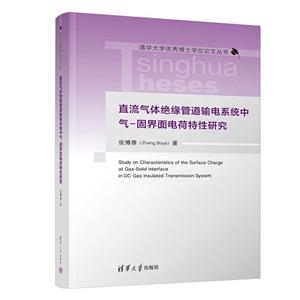-
>
湖南省志(1978-2002)?铁路志
-
>
公路车宝典(ZINN的公路车维修与保养秘籍)
-
>
晶体管电路设计(下)
-
>
基于个性化设计策略的智能交通系统关键技术
-
>
德国克虏伯与晚清火:贸易与仿制模式下的技术转移
-
>
花样百出:贵州少数民族图案填色
-
>
识木:全球220种木材图鉴
直流气体绝缘管道输电系统中气-固界面电荷特性研究 版权信息
- ISBN:9787302617501
- 条形码:9787302617501 ; 978-7-302-61750-1
- 装帧:一般胶版纸
- 册数:暂无
- 重量:暂无
- 所属分类:>>
直流气体绝缘管道输电系统中气-固界面电荷特性研究 本书特色
《直流气体绝缘管道输电系统中气-固界面电荷特性研究》入选“清华大学优秀博士学位论文丛书”。
直流气体绝缘管道输电系统中气-固界面电荷特性研究 内容简介
气体绝缘管道输电线路是一种重要的输电设备,而固-气界面电荷积聚是影响直流GIL绝缘性能的关键问题。《直流气体绝缘管道输电系统中气-固界面电荷特性研究》详细介绍了直流电场下固-气界面电荷的测量技术、电荷积聚与消散的机理和特性、以及抑制电荷积聚的方法。本书的研究成果不但具有重要的理论意义,同时具有潜在的应用价值,为我国高压直流气体绝缘设备的研制提供了重要的技术手段、理论基础和设计思路。
直流气体绝缘管道输电系统中气-固界面电荷特性研究 目录
第1章绪论
1.1研究背景及意义
1.1.1高压直流输电
1.1.2气体绝缘管道输电
1.1.3直流GIL的绝缘问题
1.2国内外研究现状
1.2.1气固界面电荷积聚的早期研究基础
1.2.2气固界面电荷积聚的近期研究动态
1.2.3气固界面电荷积聚的研究现状小结
1.2.4气固界面电荷积聚研究存在的问题
1.3本书的主要工作
第2章基于缩比GIL的气固界面电荷测量系统设计
2.1静电探头法的测量原理
2.1.1无源静电探头的测量原理
2.1.2有源静电探头的测量原理
2.1.3有源静电探头对电场的影响
2.2基于缩比GIL的气固界面电荷测量平台
2.2.1绝缘子制作和电极结构设计
2.2.2实验装置和测量平台
2.3二维平面的气固界面电荷测量平台
2.4粉尘图的制作
2.5本章小结
第3章基于数字图像处理技术的气固界面电荷反演算法
3.1电荷反演问题的提出
3.2平移改变系统的电荷反演算法
3.2.1平移改变系统及其传递函数矩阵元素
3.2.2传递函数矩阵的病态特性
3.2.3基于吉洪诺夫正则化的维纳滤波器
3.2.4基于点扩散函数的空间分辨率分析
3.2.5仿真算例及计算精度分析
3.3平移不变系统的电荷反演算法
3.3.1平移不变系统算法设计的基本原理
3.3.2二维傅里叶变换和维纳滤波器
3.3.3系统的空间分辨率分析
3.3.4仿真算例和计算精度分析
3.4实测效果和算法验证
3.5本章小结
第4章直流电场中气固界面电荷积聚特性及其动力学模型
4.1气固界面电荷积聚实验现象
4.1.1空气中的气固界面电荷积聚现象
4.1.2SF6中的气固界面电荷积聚现象
4.2气固界面电荷积聚的两种模式
4.2.1基本模式
4.2.2电荷斑模式
4.3气固界面电荷积聚的动力学模型
4.3.1建立模型
4.3.2实验结果与仿真结果的对比
4.3.3仿真体积电导率对电荷积聚的影响
4.3.4仿真表面电导率对电荷积聚的影响
4.4对气固界面电荷积聚理论的实验验证
4.4.1不同体积电导率的绝缘子表面电荷积聚
4.4.2温度梯度下的绝缘子表面电荷积聚
4.4.3高离子浓度气体中的绝缘子表面电荷积聚
4.5本章小结
第5章气固界面电荷消散特性及其动力学模型
5.1实验设计
5.1.1实验样品
5.1.2充电电路
5.1.3研究内容
5.2环氧树脂材料表面电荷消散的观测
5.2.1开放气体空间中的气固界面电荷消散
5.2.2有限气体空间中的气固界面电荷消散
5.2.3离子风中的气固界面电荷消散
5.3气固界面电荷消散的动力学过程建模
5.4数值计算结果与实验结果的对比
5.4.1体电导主导的气固界面电荷消散
5.4.2气体离子中和主导的气固界面电荷消散
5.4.3面电导主导的气固界面电荷消散
5.5材料的本征电荷消散与表面陷阱能级
5.5.1等温电流衰减理论
5.5.2陷阱密度与表面电位衰减
5.5.3表面电位衰减测量和表面陷阱能级计算
5.6本章小结
第6章抑制表面电荷积聚的环氧复合材料改性探究
6.1环氧树脂材料本体改性的研究
6.1.1Al2O3纳米颗粒掺杂
6.1.2富勒烯掺杂
6.2环氧树脂材料表面改性的研究
6.2.1表面氟化处理
6.2.2二维纳米涂层
6.3本章小结
第7章结论
参考文献
在学期间发表的学术论文与研究成果
致谢
Contents
1Introduction
1.1Research Background and Significance
1.1.1High Voltage Direct Current Transmission
1.1.2Gas Insulated Transmission Line
1.1.3Insulation Problems of GIL
1.2Research Status of GasSolid Interface Charge
Accumulation
1.2.1Early Research Basis
1.2.2Recent Research Trends
1.2.3Brief Summary of Research Status
1.2.4Existing Problems
1.3Main Contents of This Book
2Design of Surface Charge Measurement System for Downsized
GIL Model
2.1Measurement Principle of the Electrostatic Probe
2.1.1Measurement Principle of Passive Electrostatic
Probe
2.1.2Measurement Principle of Active Electrostatic
Probe
2.1.3Effect of Active Electrostatic Probe on Electric
Field
2.2Surface Charge Measuerment Platform Based on A
Downsized GIL
2.2.1Manufacture of Insulators and Design of Electrode
System
2.2.2Experimental Setup and Measurement Platform
2.3Surface Charge Measurement Platform for 2D Surface
2.4Production of DustFigure
2.5Summary
3Inversion Algorithm of Surface Charge Calculation Based on the
Digital Image Processing Technique
3.1Propose of the Inversion Algorithm for Surface Charge
Calculation
3.2Inversion Algorithm for ShiftVariant System
3.2.1ShiftVariant System and Transfer Function Matrix
Components
3.2.2The IllPosed Feature of Transfer Function
Matrix
3.2.3Wiener Filter Based on Tikhonov’s Regularization
3.2.4Spatial Resolution of the Algorithm Based on
the PSF
3.2.5Numerical Simulations and Accuracy Analysis
3.3Inversion Algorithm for ShiftInvariant System
3.3.1The Principle of Algorithm for ShiftInvariant
System
3.3.22D Fourier Transform and Wiener Filter
3.3.3Spatial Resolution Analysis
3.3.4Numerical Simulations and Accuracy Analysis
3.4Expreiment Results and the Verify of Algorithm
3.5Summary
4Surface Charge Accumulation Characteristics and Its Kinetic Model
4.1Experimental Phenomenon of Surface Charge
Accumulation
4.1.1Surface Charge Accumulation in the Air
4.1.2Surface Charge Accumulation in the SF6
4.2Two Patterns of GasSolid Interface Charge
Accumulation
4.2.1Dominant Uniform Charging
4.2.2Charge Speckles
4.3Simulation Model of GasSolid Interface Charge
Accumulation
4.3.1Model Building
4.3.2Comparison of Experimental Results and Simulation
Results
4.3.3Influence of Volume Conductivity on Charge
Accumulation
4.3.4Influence of Surface Conductivity on Charge
Accumulation
4.4Experimental Validation of Surface Charge Accumulation
Theory
4.4.1Influence of Volumn Conductivity
4.4.2Surface Charge Accumulation Under Temperature
Gradient
4.4.3Surface Charge Accumulation In Ionizing Gas
4.5Summary
5Surface Charge Dissipation Characteristics and Its Kinetic Model
5.1Experimental Design
5.1.1Test Samples
5.1.2Charging Circuit
5.1.3Research Contents
5.2Observation of Surface Charge Dissipation of Epoxy Resin
5.2.1Surface Charge Dissipation In Free Gas Volume
5.2.2Surface Charge Dissipation in Limited Gas Volume
5.2.3Surface Charge Dissipation in Ionizing Air
5.3Modeling of the Kinetic Process of Surface Charge
Dissipation
5.4Comparision of Numerical Calculations and Experimental
Results
5.4.1Surface Charge Decay Dominated by Volumn
Conducivity
5.4.2Surface Charge Decay Dominated by Gas
Neutralization
5.4.3Surface Charge Decay Dominated by Surface
Conducivity
5.5The Intrinsic Charge Dissipation and Surface Trap Energy of
Insulator
5.5.1Isothermal Current Decay theory
5.5.2Trap Denisity and Surface Potential Decay
5.5.3Surface Potential Decay Measurement and Surface
Trap Energy Caculation
5.6Summary
6Material Modification to Suppress Surfce Charge Accumulation
6.1Bulk Modification of Epoxy Resin Material
6.1.1Al2O3Filled EpoxyResin
6.1.2FullereneFilled EpoxyResin
6.2Surface Modification of Epoxy Resin Material
6.2.1Fluorination of Insulator Surface
6.2.22D NanoLaminar Coating
6.3Summary
7Conclusions
References
Published Papers and Achievements
Acknowledgements
直流气体绝缘管道输电系统中气-固界面电荷特性研究 作者简介
张博雅,分别于2013年、2018年在清华大学获得工学学士和博士学位,2016-2017年赴美国康涅狄格大学做访问研究,曾获清华大学优秀博士论文,北京市优秀博士毕业生。主要研究方向为高压电力设备沿面绝缘与放电诊断、高电压与大电流新技术、气体放电与等离子体。2018年7月进入西安交通大学电气学院从事教学科研工作,入选中国博士后创新人才支持计划。
- >
名家带你读鲁迅:故事新编
名家带你读鲁迅:故事新编
¥13.0¥26.0 - >
李白与唐代文化
李白与唐代文化
¥12.2¥29.8 - >
伯纳黛特,你要去哪(2021新版)
伯纳黛特,你要去哪(2021新版)
¥22.4¥49.8 - >
罗曼·罗兰读书随笔-精装
罗曼·罗兰读书随笔-精装
¥20.3¥58.0 - >
山海经
山海经
¥17.7¥68.0 - >
巴金-再思录
巴金-再思录
¥14.7¥46.0 - >
苦雨斋序跋文-周作人自编集
苦雨斋序跋文-周作人自编集
¥6.9¥16.0 - >
上帝之肋:男人的真实旅程
上帝之肋:男人的真实旅程
¥19.3¥35.0
-
新能源发电作业危险点分析及控制 分布式光伏分册
¥56.2¥80 -
新能源发电作业危险点分析及控制 集中式光伏分册
¥75.6¥108 -
新能源发电事故隐患重点排查手册
¥164.2¥238 -
高压电气设备试验方法(第2版)
¥84¥120 -
新能源电力企业安全设施配置规范
¥46.6¥76 -
电力安全生产月获奖征文 2012-0-2015
¥18.3¥69





















